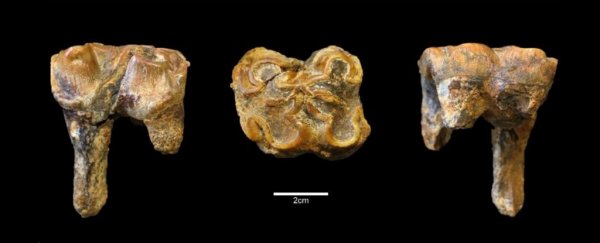A newly discovered hippo tooth reveals prehistoric hippopotamuses roamed Britain as early as 1.5 million years ago, far earlier than we thought, giving us new insights into the land's ancient climate.
"The tooth closely matches other fossils belonging to the extinct species Hippopotamus antiquus," said University of Leicester paleobiologist Neil Adams on Twitter.
Today's Britain isn't exactly known for its impressively large wildlife – red deer (Cervus elaphus) are the current largest. But like the rest of the world, it was once home to megafauna, too. It hosted woolly mammoths, cave lions, woolly rhinos, and hyenas the size of lions, and the aforementioned giant hippos.
At 3,200 kilograms, this species was more than twice the size of modern hippos (H. amphibius; 1,500 kilograms, 3,310 pounds). Ancient remains of this species have been found across Europe, from Britain to Greece, Germany, and France. Of course, back then, Britain was still connected by land to the rest of Europe.
Discovered in Westbury Cave, Somerset, England, Adams, and colleagues compared the well-preserved tooth with other hippo teeth to identify it as the left first upper molar, belonging to a hippopotamus that lived its life 1.5–1.07 million years ago.
"It is not only the first record of a hippo from the site, but also the first known hippo fossil from any site in Britain older than 750,000 years," explained Adams. "The new hippo dates to a previously unrecognized warm period in the British fossil record."
H. antiquus diet and anatomy suggest it was even more dependent on its aquatic lifestyle than modern hippos. Other fossils have shown H. antiquus eye sockets were positioned higher on its skull, and its larger body mass was supported by shorter legs – proportions far more suited to floating in the water, with spying eyes on the surface, than wobbling around on land to graze grass, like today's hippos. Isotopic analysis of its diet has also suggested the giant hippo primarily ate aquatic plants.
"Hippos are not only fabulous animals to find, but they also reveal evidence about past climates," explained University of London paleontologist Danielle Schreve. "Many megafaunal species (those over a tonne in weight) are quite broadly tolerant of temperature fluctuations, but in contrast, we know modern hippos cannot cope with seasonally frozen water bodies."
So, its presence indicates that at the time, Britain's temperature was a few degrees higher than today, with humid summers and mild winter temperatures that stayed above freezing.
The Westbury Cave fossil extends the hippo record in Britain back at least 300,000 yrs and its likely age overlaps with a particularly warm period around 1 million years ago when hippos first spread north of the Alps. [6/8] Image: Adams et al. (2021) J. Quat. Sci. pic.twitter.com/jFov6Lwnlb
— Neil Adams (@neilfadams) October 4, 2021
Other rare fossil finds dating back to the Early Pleistocene in this region paint a picture of a savanna filled with grassland grazers and carnivores like the giant hyena, mixed with areas of open woodlands populated by Etruscan rhinoceros, beavers, and lynx, and the presence of a sizable body of water for the hippos.
Europe's fossil records suggest H. antiquus species first traveled north of the Alps around 1.1 million years ago, so this specimen may have been part of that early wave of migration. Or it may be a sign of an even earlier foray north, the researchers suggest.
This research was published in the Journal of Quaternary Science.
